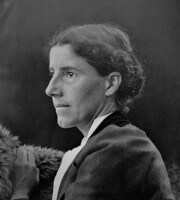About Charlotte Perkins Gilman
Charlotte Perkins Gilman, born July 3, 1860 in Hartford, Connecticut and died August 17, 1935 in Pasadena, California, was an American poet, essayist, novelist, short story writer, lecturer, diarist, journalist, editor and women's rights activist. Through her work and her lectures, she is one of the major figures of the feminist and suffragist movement and of American social philosophy at the beginning of the 20th century. Forgotten after her death, she was rediscovered by the feminist movements of the 1970s. Her novel Herland, published in 1915, is one of the best known of the first feminist and utopian science fiction novels written by a woman. Like many of her writings, they first appeared in Forerunner, her own published monthly feminist magazine from 1909 to 1916.Between 1890 and 1893, she published more than ten poems in the New Nation, which would be collected in her collection of poems In This Our World published on October 24, 1893. In This Our World, which contains seventy-three poems, is well received by literary critics in the America and United Kingdom. The success is such that the collection will know in 1895 a second enriched American edition which contains 122 poems, followed in 1898 by a third edition, also enriched, containing 149 poems.
For her unconventional ideas and lifestyle, she became a role model for future feminist generations. In 1884 she married the painter Charles Walter Stetson (1858–1911), but left him four years later – a bold step for her time. After the official divorce (1894), she left their daughter Katherine to Stetson and his new companion, the writer Grace Ellery Channing (a friend of Perkins Gilman). During the marriage she had suffered from depression, which led her to write The Yellow Wallpaper (1890) which is considered as her best-known work today with her poem Similar Cases published in the Nationalist. This poem which is a satire of the conservatism of men who, against women, still retain the spirit of prehistoric men. This poem makes Charlotte Perkins Gilman famous in all America, it was re-published by various magazines and newspapers of the Nationalism party such as the California Nationalist, the Weekly Nationalist, but also by the magazine The Pacific Monthly. Ambrose Bierce wrote in the newspaper The San Francisco Examiner: This poem is an exquisite satire for all those of us who are not fortunate enough to think that the progress of humanity towards the light would be subjected to sudden and durable accelerations. Charlotte writes in her diary on December 31, 1890: My literary reputation begins with the publication of Similar Cases and marks the beginning of my career as a lecturer. On June 10, 1890, Charlotte Perkins resumed her poem and gave it a new title, On Human Nature, and it is with this new title that she will republish it.
The Yellow Wallpaper is a semi-autobiographical story she wrote after her depression. Her main themes were women's liberation and peace. Her essay Women and Economics: a Study of the Economic Relationship Between Men and Women as a Factor in Social Evolution (1898), translated into seven languages ??at the time and continuously reissued, is considered one of the fundamental texts on the origin of the women's question and on the economic and social relations between the two sexes, which have determined the social assignment to men and women of roles and activities based on gender. In her 1911 book The Man-Made World or Our Androcentric Culture, Perkins Gilman was the first to use and define the term androcentrism. In 1915 she founded the Women's Peace Party with her friend Jane Addams. Her novel Herland, which describes a fictional miniature and mountain republic in South America consisting only of women and is considered a "pure didactic play", was published in the same year.
After her divorce, she went to San Francisco, where she found both a close friend and a teacher in the socialist writer Helen Campell, 21 years her senior. She attended many women's congresses, which led her to Berlin and London; there she met Beatrice Webb and George Bernard Shaw, among others. In 1900 she entered into her second marriage to her cousin George Gilman, a lawyer in New York, which lasted until Gilman's death (1934). In 1922, Perkins Gilman moved with her husband to Norwich, Connecticut, where she wrote His Religion and Hers (1923), a critical book of religion, and began her autobiography. Ten years later, in January 1932, she was diagnosed with incurable breast cancer. After her husband's death in 1934, she moved to California to be closer to her daughter. Supporter of euthanasia, on August 17, 1935, Charlotte committed suicide during the terminal phase of her illness by overdose of chloroform.
Browse all poems and texts published on Charlotte Perkins Gilman









